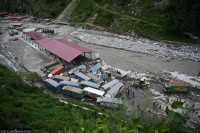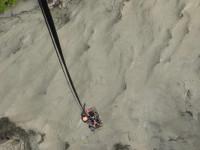Climate & Environment
Tiger photographed in Rupandehi, Kapilvastu and Palpa after several years
The latest report that recorded the sighting of tigers in three districts of the Chure region, not only shows Chure as a healthy ecosystem and home for valuable species but also calls for improved conservation of the zone, facing several challenges.
Chandan Kumar Mandal
In December last year, a Royal Bengal Tiger was captured on camera at an elevation of 3,165 metres in Ilam district of eastern Nepal. It was the first-ever sighting of the big cat at such a high altitude.
Almost nine months prior, a tiger was spotted at an elevation of 2,500 metres in the Mahabharat range of Dadeldhura district.
The two sightings of tigers had led conservationists to suspect that the big cats were moving up in the hills, possibly in search of undisturbed habitats and prey.
Now, the findings of a recent study show that tigers are not only climbing up in the hills but also moving right and left from their existing territories.
The study has found tigers in three districts where they had not been sighted—at least in recent years.
The study, ‘Report on Faunal Diversity in Chure Region of Nepal’, recorded and captured tigers in three districts— Rupandehi, Kaplivastu and Palpa—where the big cats have not been registered for many years.
“Tiger sightings in these districts show that tigers are not only moving towards hills but going around in other directions as well,” said Baburam Lamichhane, one of the researchers. “The sightings also show that their area is further expanding.”
In recent years, tiger habitats have been confined in the country’s protected areas in southern plains—Parsa National Park, Chitwan National Park, Banke National Park, Bardiya National Park and Shuklaphanta National Park—and their adjoining forests.
The latest tiger census in 2018 detected signs of tiger presence in 12 districts—Bara, Parsa, Makwanpur, Chitwan, Nawalparasi, Dang, Salyan, Banke, Bardiya, Surkhet, Kailali and Kanchanpur—of the 18 districts surveyed across all potential tiger habitats in the Terai Arc Landscape (TAL).
With the increase in tiger population, big cats are seen straying outside their habitats and getting closer to human settlements, resulting in conflicts with communities. Still, these districts had not recorded tiger presence lately.
The study, which was conducted to assess fauna diversity in the country’s Chure range, detected at least two individuals—a male and a female— tigers in Kapilvastu, Rupandehi and Palpa.
These tigers were spotted in the forests North-west of Butwal city where no tigers were recorded in 2008-09, 2013 and 2018 national tiger and prey base surveys, according to the study.
“There had been records of tiger pugmarks in Kapilvastu district in the past. But the presence of tiger was not documented in Rupandehi and Palpa districts in any tiger censuses since 2009,” said Lamichhane, who has conducted several researches on tigers in the country. “Although these districts also lie in the Terai Arc Landscape, there was no recent sighting of tigers there. This is a new record.”
For assessment of fauna presence in Chure region, which spreads across east-west covering 12.8 percent of the total area of Nepal, researchers had deployed various methods, including camera traps for recording large mammals like tigers.
The camera trap study was conducted in 1,695 grids, an area of 10km x 10km, covering the entire Chure region.
According to Lamichhane, one tiger was captured on camera along the Rupandehi-Palpa border, whereas the other sightings were recorded in Kapilvastu.
“The female tigress looks like moving from east to west, and the male one seems to be coming from the west direction. The tiger spotted in Kapilvastu was captured nearby Dang district,” said Lamichhane, who is also the chief of the Biodiversity Conservation Centre, Sauraha, under the National Trust for Nature Conservation.
“Such movement of tigers indicates their east-west connection. In 2001, the Terai Arc Landscape was envisioned for connecting the tiger population. The study provides conclusive evidence that tigers are using the area, and their connection is possible.”
Sighting of tigers in these three districts, which are not even touched by nearby protected areas, shows the big cats must have crossed a large area, possibly the whole district, using the forest corridor.
For a tiger from Banke National Park to reach Kapilvastu, where it was photographed during the study, it has to cross the whole Dang district. Likewise, for a tiger from Chitwan National Park to be captured on camera in Rupandehi, it has to cross Nawalparasi.
The Chure range, which is spread across Nepal’s 36 districts with an elevation ranging between 93 and 1,955m, serves as a habitat for various rare and globally threatened species.
Nearly 76 percent of the forest area in the Chure region falls outside the protected areas, facing various threats like deforestation, excessive mining of riverbed materials and overgrazing.
There were also no formal records of biodiversity, mainly fauna diversity, of the Chure range. The National Trust for Nature Conservation carried out the faunal diversity assessment in the Chure region with the financial support of President Chure Terai Madhes Conservation Development Board.
The study has recorded a rich presence of fauna in the region, recording 41 different species of mammals based on camera trap photographs. Out of 41 mammals, 20 were listed in the IUCN red list of threatened species, including one critically endangered, five endangered, nine vulnerable and three near threatened.
“There are chances of more mammal species present in the region as the camera trap method could have missed small mammals,” said Lamichhane.
Researchers could photograph a Sloth bear from Trijuga forest, north-west of Koshi Tappu Wildlife Reserve, where a sloth bear was not recorded before.
Likewise, among the 27 protected mammal species in Nepal, striped hyena and leopard cat has a wider distribution in the Chure region, according to the findings. The study concluded that critically endangered Chinese pangolin were photographed from two locations in Chure—Chitwan and Udaypur districts.
Also, among the five ‘endangered’ species, dhole and hog deer were recorded exclusively inside the protected areas, and Indian pangolin, tiger and elephant were also recorded outside of protected areas.
The study recorded 45,113 individual birds belonging to a total of 378 different bird species, which is 42.78 percent of total bird species in Nepal, in Chure. Researchers also documented eight globally threatened and 35 nationally threatened and Rare bird species during the survey.
Similarly, a total of 99 species of herpetofauna (24 species of amphibians and 75 species of reptiles) were recorded, including two new species records (a frog and a monitor lizard) for Nepal from the Chure region, said the study.
The water (or Asian) monitor lizard (Varanus Salvator) was recorded for the first time in Nepal in Udayapur district.
Besides, a total of 279 species of butterflies, including 18 new records for the country, belonging to six families, were recorded. Lastly, 104 species of fish were also documented during the survey.
“Record of two tigers (a male and a female) during this study in the forests of Chure in Kapilvastu and western part of Rupandehi shows the significance of this area for biodiversity conservation. Tiger is an indicator of a healthy ecosystem,” read the report. “Only a good habitat can provide enough prey base to sustain tigers. Along with tigers other co-predators like leopards, hyaena, jackal; prey species such as chital, barking deer, wild boar were also recorded. Thus, this region is another important area in Western Chure.”
The study also concluded that photographs of tigers in Rupandehi, Palpa and Kapilvastu highlighted the significance of Chure forests and indicated the possibility of population connectivity dispersal of tigers between the Parsa-Chitwan-Parsa and Banke-Bardiya tiger populations.
However, the Chure region, a fragile zone already facing degradation due to massive exploitation of natural resources, faces other challenges like habitat fragmentation, encroachment and loss; livestock grazing; sand and gravel extraction and forest resources collection; hunting and poaching of wildlife and human-wildlife conflict, the study pointed out.
All these challenges in biodiversity conservation emanate from high human pressure and ongoing development in the region.
Deployed camera traps captured 58 images of people with guns in seven different grids, suggesting widespread wildlife poaching. The study has also pointed out seven pocket areas for biodiversity conservation.
According to wildlife experts like Lamichhane, conservation of the Chure range is not only for preserving ecological services for people living downstream in the Tarai but also for protecting the rich biodiversity the region supports.
“The study of the range is a vital zone for valuable species. It can support connectivity for tigers from east to west. The tiger photographed during the study must have walked along the Chure range,” said Lamichhane, one of the researchers. “The study findings also call for focused effort even outside the protected areas. With the presence of the tiger outside these parks, it is evident that the region deserves more attention for the conservation of tigers and other species.”




 17.12°C Kathmandu
17.12°C Kathmandu










